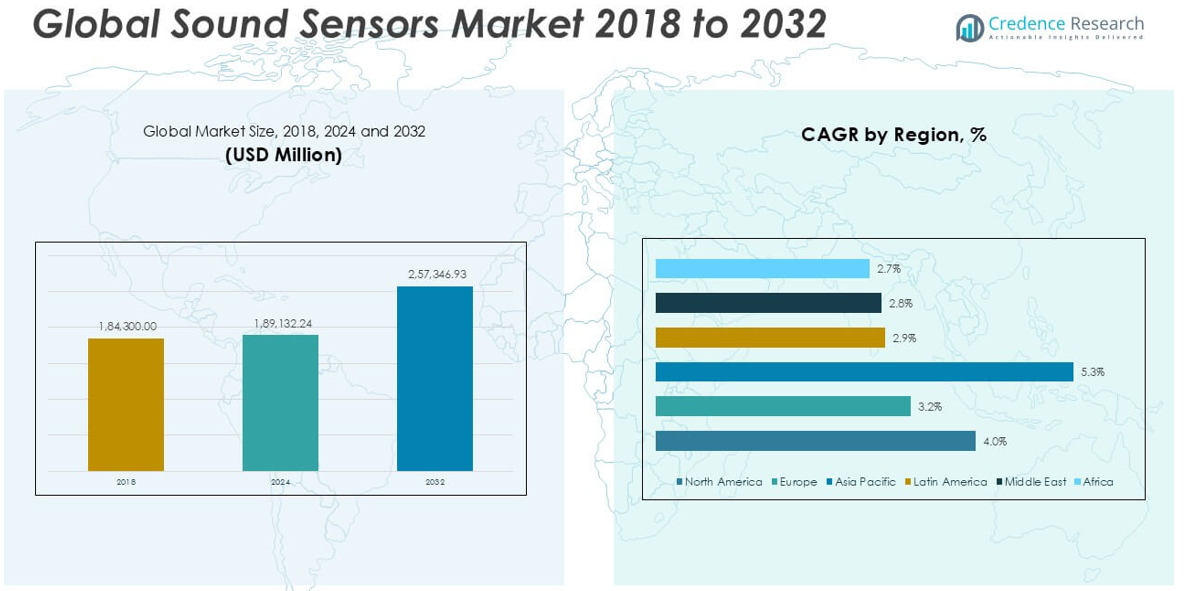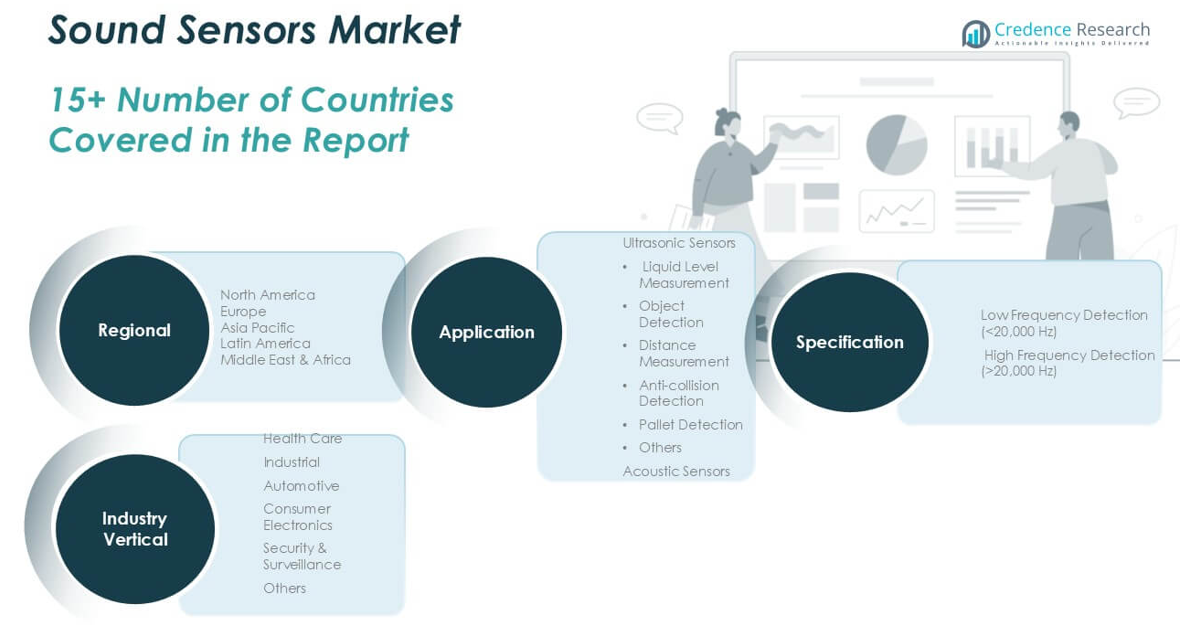CHAPTER NO. 1 : GENESIS OF THE MARKET
1.1 Market Prelude – Introduction & Scope
1.2 The Big Picture – Objectives & Vision
1.3 Strategic Edge – Unique Value Proposition
1.4 Stakeholder Compass – Key Beneficiaries
CHAPTER NO. 2 : EXECUTIVE LENS
2.1 Pulse of the Industry – Market Snapshot
2.2 Growth Arc – Revenue Projections (USD Million)
2.3. Premium Insights – Based on Primary Interviews
CHAPTER NO. 3 : SOUND SENSORS MARKET FORCES & INDUSTRY PULSE
3.1 Foundations of Change – Market Overview
3.2 Catalysts of Expansion – Key Market Drivers
3.2.1 Momentum Boosters – Growth Triggers
3.2.2 Innovation Fuel – Disruptive Technologies
3.3 Headwinds & Crosswinds – Market Restraints
3.3.1 Regulatory Tides – Compliance Challenges
3.3.2 Economic Frictions – Inflationary Pressures
3.4 Untapped Horizons – Growth Potential & Opportunities
3.5 Strategic Navigation – Industry Frameworks
3.5.1 Market Equilibrium – Porter’s Five Forces
3.5.2 Ecosystem Dynamics – Value Chain Analysis
3.5.3 Macro Forces – PESTEL Breakdown
3.6 Price Trend Analysis
3.6.1 Regional Price Trend
3.6.2 Price Trend by product
CHAPTER NO. 4 : KEY INVESTMENT EPICENTER
4.1 Regional Goldmines – High-Growth Geographies
4.2 Product Frontiers – Lucrative Product Categories
4.3 Deployment Sweet Spots – Emerging Demand Segments
CHAPTER NO. 5: REVENUE TRAJECTORY & WEALTH MAPPING
5.1 Momentum Metrics – Forecast & Growth Curves
5.2 Regional Revenue Footprint – Market Share Insights
5.3 Segmental Wealth Flow – Specification & Deployment Revenue
CHAPTER NO. 6 : TRADE & COMMERCE ANALYSIS
6.1. Import Analysis by Region
6.1.1. Global Sound Sensors Market Import Revenue By Region
6.2. Export Analysis by Region
6.2.1. Global Sound Sensors Market Export Revenue By Region
CHAPTER NO. 7 : COMPETITION ANALYSIS
7.1. Company Market Share Analysis
7.1.1. Global Sound Sensors Market: Company Market Share
7.2. Global Sound Sensors Market Company Revenue Market Share
7.3. Strategic Developments
7.3.1. Acquisitions & Mergers
7.3.2. New Product Launch
7.3.3. Regional Expansion
7.4. Competitive Dashboard
7.5. Company Assessment Metrics, 2024
CHAPTER NO. 8 : SOUND SENSORS MARKET – BY SPECIFICATION SEGMENT ANALYSIS
8.1. Sound Sensors Market Overview by Specification Segment
8.1.1. Sound Sensors Market Revenue Share By Specification
8.2. Low Frequency Detection (<20,000 Hz)
8.3. High Frequency Detection (>20,000 Hz)
CHAPTER NO. 9 : SOUND SENSORS MARKET – BY INDUSTRY VERTICAL SEGMENT ANALYSIS
9.1. Sound Sensors Market Overview by Industry Vertical Segment
9.1.1. Sound Sensors Market Revenue Share By Industry Vertical
9.2. Health Care
9.3. Industrial
9.4. Automotive
9.5. Consumer Electronics
9.6. Security & Surveillance
9.7. Others
CHAPTER NO. 10 : SOUND SENSORS MARKET – BY APPLICATION SEGMENT ANALYSIS
10.1. Sound Sensors Market Overview by Application Segment
10.1.1. Sound Sensors Market Revenue Share By Application
10.2. Ultrasonic Sensors
10.2.1 Liquid Level Measurement
10.2.2 Object Detection
10.2.3 Distance Measurement
10.2.4 Anti-collision Detection
10.2.5 Pallet Detection
10.2.6 Others
10.3. Acoustic Sensors
CHAPTER NO. 11 : SOUND SENSORS MARKET – REGIONAL ANALYSIS
11.1. Sound Sensors Market Overview by Region Segment
11.1.1. Global Sound Sensors Market Revenue Share By Region
11.1.2. Regions
11.1.3. Global Sound Sensors Market Revenue By Region
11.1.4. Specification
11.1.5. Global Sound Sensors Market Revenue By Specification
11.1.6. Deployment
11.1.7. Global Sound Sensors Market Revenue By Deployment
11.1.8. Industry Vertical
11.1.9. Global Sound Sensors Market Revenue By Industry Vertical
11.1.10. Application
11.1.11. Global Sound Sensors Market Revenue By Application
CHAPTER NO. 12 : NORTH AMERICA SOUND SENSORS MARKET – COUNTRY ANALYSIS
12.1. North America Sound Sensors Market Overview by Country Segment
12.1.1. North America Sound Sensors Market Revenue Share By Region
12.2. North America
12.2.1. North America Sound Sensors Market Revenue By Country
12.2.2. Specification
12.2.3. North America Sound Sensors Market Revenue By Specification
12.2.4. Deployment
12.2.5. North America Sound Sensors Market Revenue By Deployment
12.2.6. Industry Vertical
12.2.7. North America Sound Sensors Market Revenue By Industry Vertical
12.2.8. Application
12.2.9. North America Sound Sensors Market Revenue By Application
12.3. U.S.
12.4. Canada
12.5. Mexico
CHAPTER NO. 13 : EUROPE SOUND SENSORS MARKET – COUNTRY ANALYSIS
13.1. Europe Sound Sensors Market Overview by Country Segment
13.1.1. Europe Sound Sensors Market Revenue Share By Region
13.2. Europe
13.2.1. Europe Sound Sensors Market Revenue By Country
13.2.2. Specification
13.2.3. Europe Sound Sensors Market Revenue By Specification
13.2.4. Deployment
13.2.5. Europe Sound Sensors Market Revenue By Deployment
13.2.6. Industry Vertical
13.2.7. Europe Sound Sensors Market Revenue By Industry Vertical
13.2.8. Application
13.2.9. Europe Sound Sensors Market Revenue By Application
13.3. UK
13.4. France
13.5. Germany
13.6. Italy
13.7. Spain
13.8. Russia
13.9. Rest of Europe
CHAPTER NO. 14 : ASIA PACIFIC SOUND SENSORS MARKET – COUNTRY ANALYSIS
14.1. Asia Pacific Sound Sensors Market Overview by Country Segment
14.1.1. Asia Pacific Sound Sensors Market Revenue Share By Region
14.2. Asia Pacific
14.2.1. Asia Pacific Sound Sensors Market Revenue By Country
14.2.2. Specification
14.2.3. Asia Pacific Sound Sensors Market Revenue By Specification
14.2.4. Deployment
14.2.5. Asia Pacific Sound Sensors Market Revenue By Deployment
14.2.6. Industry Vertical
14.2.7. Asia Pacific Sound Sensors Market Revenue By Industry Vertical
14.2.8. Application
14.2.9. Asia Pacific Sound Sensors Market Revenue By Application
14.3. China
14.4. Japan
14.5. South Korea
14.6. India
14.7. Australia
14.8. Southeast Asia
14.9. Rest of Asia Pacific
CHAPTER NO. 15 : LATIN AMERICA SOUND SENSORS MARKET – COUNTRY ANALYSIS
15.1. Latin America Sound Sensors Market Overview by Country Segment
15.1.1. Latin America Sound Sensors Market Revenue Share By Region
15.2. Latin America
15.2.1. Latin America Sound Sensors Market Revenue By Country
15.2.2. Specification
15.2.3. Latin America Sound Sensors Market Revenue By Specification
15.2.4. Deployment
15.2.5. Latin America Sound Sensors Market Revenue By Deployment
15.2.6. Industry Vertical
15.2.7. Latin America Sound Sensors Market Revenue By Industry Vertical
15.2.8. Application
15.2.9. Latin America Sound Sensors Market Revenue By Application
15.3. Brazil
15.4. Argentina
15.5. Rest of Latin America
CHAPTER NO. 16 : MIDDLE EAST SOUND SENSORS MARKET – COUNTRY ANALYSIS
16.1. Middle East Sound Sensors Market Overview by Country Segment
16.1.1. Middle East Sound Sensors Market Revenue Share By Region
16.2. Middle East
16.2.1. Middle East Sound Sensors Market Revenue By Country
16.2.2. Specification
16.2.3. Middle East Sound Sensors Market Revenue By Specification
16.2.4. Deployment
16.2.5. Middle East Sound Sensors Market Revenue By Deployment
16.2.6. Industry Vertical
16.2.7. Middle East Sound Sensors Market Revenue By Industry Vertical
16.2.8. Application
16.2.9. Middle East Sound Sensors Market Revenue By Application
16.3. GCC Countries
16.4. Israel
16.5. Turkey
16.6. Rest of Middle East
CHAPTER NO. 17 : AFRICA SOUND SENSORS MARKET – COUNTRY ANALYSIS
17.1. Africa Sound Sensors Market Overview by Country Segment
17.1.1. Africa Sound Sensors Market Revenue Share By Region
17.2. Africa
17.2.1. Africa Sound Sensors Market Revenue By Country
17.2.2. Specification
17.2.3. Africa Sound Sensors Market Revenue By Specification
17.2.4. Deployment
17.2.5. Africa Sound Sensors Market Revenue By Deployment
17.2.6. Industry Vertical
17.2.7. Africa Sound Sensors Market Revenue By Industry Vertical
17.2.8. Application
17.2.9. Africa Sound Sensors Market Revenue By Application
17.3. South Africa
17.4. Egypt
17.5. Rest of Africa
CHAPTER NO. 18 : COMPANY PROFILES
18.1. Maxbotix, Inc.
18.1.1. Company Overview
18.1.2. Product Portfolio
18.1.3. Financial Overview
18.1.4. Recent Developments
18.1.5. Growth Strategy
18.1.6. SWOT Analysis
18.2. Siemens AG
18.3. ST Microelectronics, Inc.
18.4. Sensor Technology Ltd.
18.5. Benthowave Instrument Inc.
18.6. Murata Manufacturing Co., Ltd.
18.7. OMRON Corporation
18.8. Hubbell Incorporated
18.9. Transense Technologies plc.
18.10. TE Connectivity Ltd.
18.11 CetResTec, Inc
18.12. CTS Corporation
18.13 GENERAL ELECTRIC
18.14 MaxBotix Inc
18.15 Teledyne Technologies Incorporated
18.16 HONEYWELL INTERNATIONAL INC
18.17 Seiko Epson Corp
18.18 API Technologies Corp
18.19 BOSTON PIEZO-OPTICS INC
18.20 Panasonic Corporation
18.21 Autodesk Inc.









